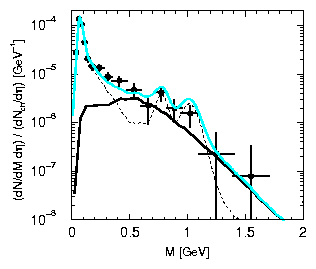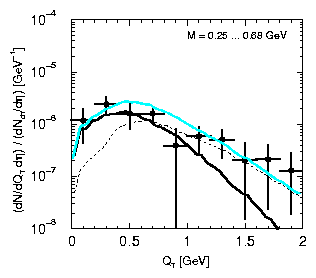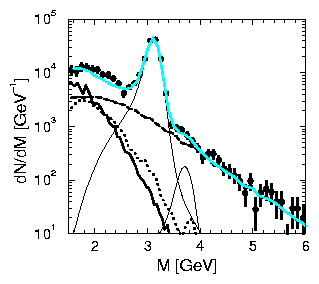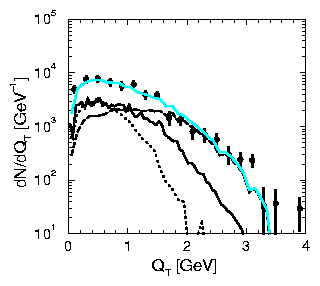| Analysis of Dilepton Data from Heavy-Ion Experiments at CERN-SPS B,W | |||||||||
|---|---|---|---|---|---|---|---|---|---|
| K. Gallmeister, B. Kämpfer, O.P. Pavlenko1, C. Gale2 | |||||||||
|
An excess of dileptons in lead-beam induced
heavy-ion collisions has been reported (i) by the CERES collaboration
in the low-mass region of dielectrons and (ii) by the NA50
collaboration in the intermediate-mass region of dimuons.
This excess points to the existence of a system of thermalized matter
emitting dileptons [1].
Fig. 1 A comparison of our model with the CERES data. The dashed curves are the hadronic cocktail published by the CERES collaboration, the solid curves are the contributions from the thermal system. The sum is depicted by the gray curves. Left panel: the invariant mass spectrum, right panel: the transverse momentum spectrum for the invariant mass region M = 0.25...0.68 GeV.
Fig. 2 The data of the NA50 collaboration for the invariant mass spectrum (left) and the transverse momentum spectrum in the invariant mass region M = 1.5...2.5 GeV (right). The dashed curves are the Drell-Yan contributions, the dotted curves show the contributions of open charm and the solid lines depict the yield of the thermal system. The sum is shown by the gray curves.
1Institute for Theoretical Physics, 252143 Kiev - 143, Ukraine
References
[1] K. Gallmeister, B. Kämpfer, O.P. Pavlenko, Phys. Lett. B 473, 20 (2000)
[2] K. Gallmeister, B. Kämpfer, O.P. Pavlenko, C. Gale, Nucl. Phys. A 688, 933 (2001)
|



